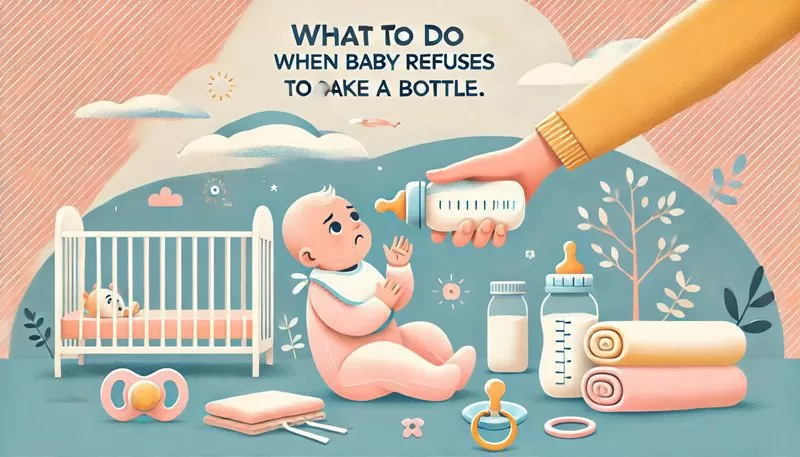Table of Contents
Baby Refuses Bottle Feeding
One of the most challenging moments for parents is when their baby refuses to take a bottle. Whether you’re transitioning from breastfeeding or introducing the bottle for the first time, a baby’s rejection of the bottle can cause stress and worry. But don’t panic—there are plenty of strategies and products that can help ease this transition. In this guide, we’ll explore what to do when your baby won’t take a bottle and offer valuable insights and product recommendations to make the process smoother.
One common reason why babies may refuse the bottle is due to a poor latch or discomfort with the nipple size. To help resolve this, it’s important to explore expert tips on how to get baby to take a bottle, which offers comprehensive guidance on ensuring your baby gets the best feeding experience. Addressing these issues early can make all the difference in your baby’s feeding routine.
Understanding Why Your Baby Won’t Take the Bottle

Before diving into solutions, it’s essential to understand why your baby might be refusing the bottle. There are several reasons, and identifying the cause can help you find the best approach. Some common reasons include:
- Nipple Confusion: If your baby has been exclusively breastfeeding, they may have difficulty switching between the breast and bottle.
- Temperature Preferences: Your baby may prefer their milk at a certain temperature, and bottles may not match their preference.
- Flow Rate: Babies may refuse the bottle if the nipple’s flow rate is too fast or too slow.
- Timing: Introducing the bottle when your baby is too hungry or not hungry enough may cause them to reject it.
Once you’ve identified potential reasons, it’s easier to find a solution tailored to your baby’s needs.
If your baby is refusing to take a bottle, you might find that introducing solids can be a helpful transition. In Introducing Solids Without the Stress: A Guide for Parents, we explore practical tips for starting your baby on solid foods while ensuring a smooth feeding experience. This guide offers insights on how to create a calm environment, which can be particularly beneficial when your little one is hesitant about bottle feeding. By implementing the strategies discussed, you can make the transition to solids easier for both you and your baby.
What to Do When Your Baby Won’t Take a Bottle

If your baby is struggling with the transition to the bottle, there are several techniques you can try to make the process easier. Here are some practical steps to help your baby get accustomed to bottle feeding:
- Start Gradually: Begin by offering the bottle during a time when your baby is calm and not too hungry. This creates a less stressful environment for both of you.
- Try Different Nipple Shapes: Sometimes, switching to a different nipple that mimics the feel of breastfeeding can help. Our Natural Flow Baby Bottle Nipples are designed to replicate the breastfeeding experience, making the transition smoother.
- Check the Temperature: Babies often prefer milk at a specific temperature. Warm the bottle to match the temperature of breast milk, using our Bottle Warmer to ensure it’s just right for your baby.
By experimenting with these steps, you can find what works best for your baby when they refuse the bottle.
Baby Refusing the Bottle? Try These Tips

It’s not uncommon for babies to refuse the bottle at first, but persistence and patience are key. Here are some additional tips that might help when your baby refuses the bottle:
- Let Someone Else Offer the Bottle: If your baby associates you with breastfeeding, they may refuse the bottle from you. Have your partner or another caregiver offer the bottle while you’re out of sight. Sometimes, the absence of mom makes babies more willing to accept the bottle.
- Try Different Feeding Positions: Babies may prefer different feeding positions when bottle-feeding. Experiment with positions that mimic breastfeeding, or try holding your baby in an upright position. The key is to find what’s comfortable for both of you.
- Use a Soothing Method: Before offering the bottle, try soothing your baby by rocking or swaying. This can help them feel more relaxed and open to taking the bottle. Our Ergonomic Baby Carrier is perfect for soothing and holding your baby in a comfortable position while preparing to feed.
It’s important to be patient and continue to offer the bottle, even if your baby initially resists. Consistency and a calm approach are often key to success.
Transitioning your baby from breastfeeding to bottle feeding can be a challenging process, especially if your little one is resistant to the change. It’s essential to approach this transition with patience and understanding. To make the process smoother, consider exploring our article, Breast to Bottle: Tips for Transitioning to Bottle Feeding. In this guide, you’ll find valuable insights and practical strategies that can help ease the transition for both you and your baby, ensuring a more comfortable feeding experience.
What to Do When Baby Refuses the Bottle

If your baby continues to refuse the bottle despite trying various techniques, it’s essential to remain calm and patient. A baby’s refusal can be temporary, and eventually, most babies will adapt to the bottle. However, here are a few extra techniques to consider:
- Introduce the Bottle at a Different Time: Sometimes, changing when you introduce the bottle can help. Instead of trying during feeding time, offer the bottle in between feedings when your baby is calm and less hungry.
- Create a Relaxing Environment: Make bottle-feeding a peaceful experience by reducing distractions. Dim the lights, play soft music, or use a white noise machine to create a soothing atmosphere. Our Portable White Noise Machine can help make feeding time more relaxing for your baby.
- Try a Paced Feeding Method: Paced bottle-feeding mimics breastfeeding by allowing your baby to control the flow of milk. This can help reduce the chances of overwhelming your baby with too much milk at once.
These additional methods might take time, but they can help encourage your baby to accept the bottle without frustration.
Overcoming Common Challenges

There are a few common challenges when dealing with bottle refusal. These challenges can be stressful for parents, but solutions are available:
- Baby Only Wants to Breastfeed: If your baby is exclusively breastfeeding, transitioning to a bottle may take extra time. Offering the bottle regularly and being patient with the process is crucial. Don’t be discouraged if progress is slow—some babies take longer to adapt.
- Baby Won’t Take the Bottle from Anyone: If your baby won’t take the bottle from anyone, consider trying different caregivers or offering the bottle when your baby is sleepy.
- Teething Baby Refusing Bottle: If teething is the issue, your baby may be rejecting the bottle because their gums are sore. In this case, try using a chilled teether or gum-soothing gel before offering the bottle.
By identifying these challenges, you can adapt your approach to make feeding less stressful for your baby.
Recap: What to Do When Your Baby Won’t Take a Bottle
Dealing with bottle refusal can be a frustrating experience for any parent, but by taking the time to understand your baby’s preferences and trying various techniques, you’ll find the method that works. Whether it’s using a different nipple shape, adjusting the temperature, or changing feeding positions, persistence is key.
Remember, every baby is different, and what works for one might not work for another. Be patient, and don’t hesitate to try different products that can aid in this transition. Products like our Natural Flow Baby Bottle Nipples, Bottle Warmer, and Ergonomic Baby Carrier can make the bottle-feeding experience smoother and more comfortable for both you and your baby.
If you’re facing challenges with your baby refusing to take a bottle, it’s essential to consider the foundation of your breastfeeding journey. For new parents, understanding the nuances of breastfeeding can make a significant difference in establishing a successful feeding routine. Our comprehensive Breastfeeding Guide: How to Get Off to a Great Start offers valuable insights and tips to help you navigate common hurdles. From latching techniques to managing milk supply, this guide is designed to support you and your baby as you transition between breastfeeding and bottle-feeding
Conclusion
What to do when your baby won’t take a bottle can feel overwhelming, but with these strategies, you’ll be better equipped to handle the challenge. Remember to stay patient and keep trying different methods until you find the one that works for your baby. Every baby is unique, and with the right products and techniques, bottle-feeding will soon become a seamless part of your routine.
Baby refusing the bottle? Try these tips, and don’t forget to explore our store for helpful products designed to make feeding time easier. From bottle warmers to ergonomic carriers, we’ve got everything you need to support your baby’s transition to bottle-feeding. So, if you’re wondering what to do when baby refuses the bottle, just remember—persistence and the right tools are your best allies.

